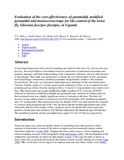| dc.contributor.author | Abila, PP | |
| dc.contributor.author | Okello-Onen, J | |
| dc.contributor.author | Okoth, JO | |
| dc.contributor.author | Matete, GO | |
| dc.contributor.author | Wamwiri, F | |
| dc.contributor.author | Politzar, H | |
| dc.date.accessioned | 2013-06-13T15:18:08Z | |
| dc.date.available | 2013-06-13T15:18:08Z | |
| dc.date.issued | 2007 | |
| dc.identifier.citation | J Insect Sci. 2007;7:1-7 | en |
| dc.identifier.uri | http://hinari-gw.who.int/whalecomwww.ncbi.nlm.nih.gov/whalecom0/pubmed/20345292 | |
| dc.identifier.uri | http://erepository.uonbi.ac.ke:8080/xmlui/handle/123456789/33354 | |
| dc.description.abstract | Several trap designs have been used for sampling and control of the tsetse fly, Glossina fuscipes fuscipes, Newstead (Diptera: Glossinidae) based on preferences of individual researchers and program managers with little understanding of the comparative efficiency and cost-effectiveness of trap designs. This study was carried out to evaluate the cost-effectiveness of four commonly used trap designs: monoscreen, modified pyramidal and pyramidal, relative to the standard biconical trap. The study was performed under high tsetse challenge on Buvuma Island, Lake Victoria, Uganda, using a 4 x 4 Latin square design replicated 3 times, so as to separate the trap positions and day effects from the treatment effect. A total of 12 trap positions were tested over 4 days. The monoscreen trap caught significantly higher numbers of G. f. fuscipes (P<0.05) followed by biconical, modified pyramidal and pyramidal traps. Analysis of variance showed that treatment factor was a highly significant source of variation in the data. The index of increase in trap catches relative biconical were 0.60 (pyramidal), 0.68 (modified pyramidal) and 1.25 (monoscreen). The monoscreen trap was cheaper (US$ 2.61) and required less material to construct than pyramidal trap (US$ 3.48), biconical and the modified pyramidal traps (US$ 4.06 each). Based on the number of flies caught per meter of material, the monoscreen trap proved to be the most cost-effective (232 flies/m) followed by the biconical trap (185 flies/m). The modified pyramidal and the pyramidal traps caught 112 and 125 flies/m, respectively. | en |
| dc.language.iso | en | en |
| dc.publisher | University of Nairobi. | en |
| dc.title | Evaluation of the cost-effectiveness of pyramidal, modified pyramidal and monoscreen traps for the control of the tsetse fly, Glossina fuscipes fuscipes, in Uganda | en |
| dc.type | Article | en |
| local.publisher | Department of Pathology, Microbiology and Parasitology, Faculty of Veterinary Medicine, University of Nairobi, Kenya. | en |

